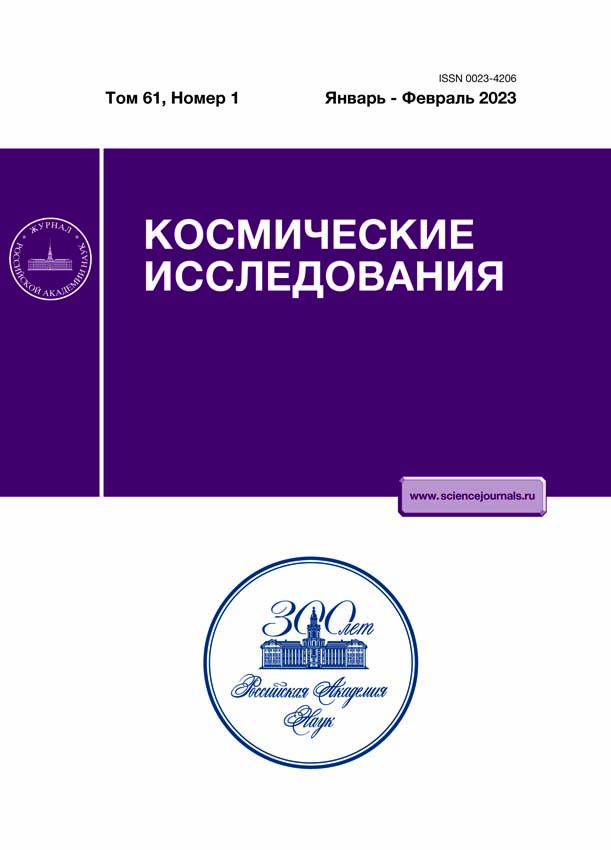Characteristics of Solar Wind and Geomagnetic Conditions of Extreme Geomagnetically Induced Currents at the Vykhodnoy Station (2012–2018)
- Autores: Sheveleva D.A.1, Apatenkov S.V.2,1, Sakharov Y.A.3, Selivanov V.N.4, Gordeev E.I.1
-
Afiliações:
- St. Petersburg State University, St. Petersburg, Russia
- Department of Physics, Harbin Institute of Technology, Harbin, China
- Polar Geophysical Institute, Russian Academy of Sciences, Apatity, Russia
- Northern Energetics Research Centre KSC Russian Academy of Sciences, Apatity, Russia
- Edição: Volume 61, Nº 1 (2023)
- Páginas: 39-42
- Seção: Articles
- URL: https://rjmseer.com/0023-4206/article/view/672696
- DOI: https://doi.org/10.31857/S0023420623010053
- EDN: https://elibrary.ru/FHVPGT
- ID: 672696
Citar
Texto integral
Resumo
We investigated 140 events with the largest geomagnetically induced currents (GIC) recorded at the Vykhodnoy station (65 MLat) in 2012–2018. The significant differences between the parameters of the solar wind and geomagnetic indices from typical values are shown. Distinctive increases in solar wind velocity and dynamic pressure, decreases of IMF Bz are found. The Kp, AE, AL, Dst indices, as well as the Dst rate of growth Dst/dt are significantly shifted from the usual values. The relationship with interplanetary shocks in the solar wind is also analyzed.
Sobre autores
D. Sheveleva
St. Petersburg State University, St. Petersburg, Russia
Email: st035310@student.spbu.ru
Россия, Санкт-Петербург
S. Apatenkov
Department of Physics, Harbin Institute of Technology, Harbin, China; St. Petersburg State University, St. Petersburg, Russia
Email: st035310@student.spbu.ru
Китай, Харбин; Россия, Санкт-Петербург
Ya. Sakharov
Polar Geophysical Institute, Russian Academy of Sciences, Apatity, Russia
Email: st035310@student.spbu.ru
Россия, Апатиты
V. Selivanov
Northern Energetics Research Centre KSC Russian Academy of Sciences, Apatity, Russia
Email: st035310@student.spbu.ru
Россия, Апатиты
E. Gordeev
St. Petersburg State University, St. Petersburg, Russia
Autor responsável pela correspondência
Email: st035310@student.spbu.ru
Россия, Санкт-Петербург
Bibliografia
- Apatenkov S.V., Sergeev V.A., Pirjola R. et al. Evaluation of the geometry of ionospheric current systems related to rapid geomagnetic variations. // Annales Geophysicae. 2004. V. 22(1). P. 63–72. https://doi.org/10.5194/angeo-22-63-2004
- Engebretson M.J., Steinmetz E.S., Posch J.L. et al. Nighttime magnetic perturbation events observed in Arctic Canada: 2. Multiple-instrument observations // Journal of Geophysical Research: Space Physics. 2019. V.124. P. 7459–7476.https://doi.org/10.1029/2019JA026797
- Huttunen K.E.J., Kilpua S.P., Pulkkinen A. et al. Solar wind drivers of large geomagnetically induced currents during the solar cycle 23 // Space Weather. 2008.V. 6. S10002.https://doi.org/10.1029/2007SW000374
- King J.H., Papitashvili N.E. Solar wind spatial scales in and comparisons of hourly Wind and ACE plasma and magnetic field data // Journal of Geophysical Research. 2005. V. 110. № A2. A02209.https://doi.org/10.1029/2004JA010649
- Pulkkinen A., Bernabeu E., Thomson A. et al. Geomagnetically induced currents: Science, engineering, and applications readiness. // Space Weather. 2017. V. 15. P. 828–856.https://doi.org/10.1002/2016SW001501
- Sakharov Y.A., Danilin A.N., Ostafiychuk R.M. Registration of GIC in power systems of the Kola Peninsula // The 7th international symposium on electromagnetic compatibility and electromagnetic ecology. Saint-Petersburg. Russia. IEEE. 2007. P. 291–292.https://doi.org/10.1109/EMCECO.2007.4371714
- Weigel R.S., Klimas A.J., Vassiliadis D. Solar wind coupling to and predictability of ground magnetic fields and their time derivatives // Journal of Geophysical Research Atmospheres. 2003. V. 108(A7). https://doi.org/10.1029/2002JA009627
Arquivos suplementares












